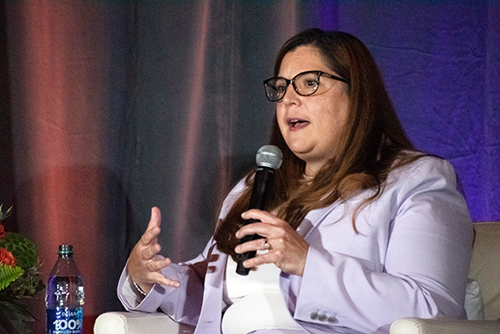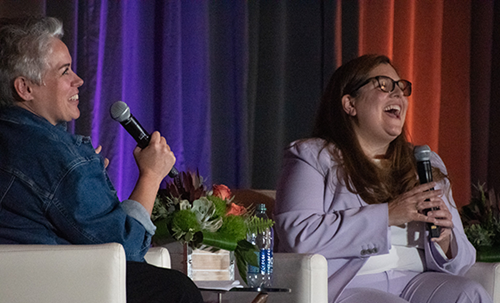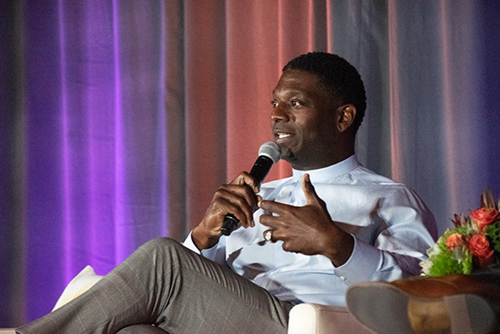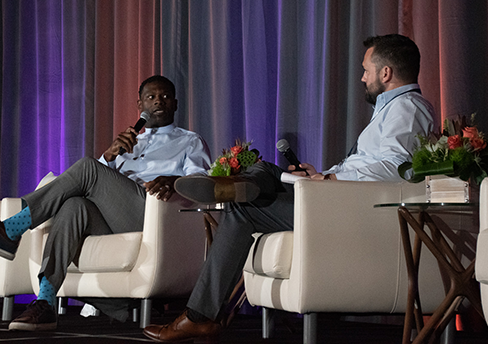It’s our biggest RISE West conference yet with a record-breaking number of more than 750 attendees and 84 sponsors who have gathered in Dallas for our annual Medicare Advantage senior leadership conference. Here are highlights from this morning’s sessions with Megan Tinker, chief of staff at the Office of Inspector General (OIG); National Football League great LaDainian Tomlinson; and a leadership panel on positioning your plan for success.
Hot off the press: OIG releases a Managed Care Strategic Plan, urges MA partnerships with MA plans
During a keynote fireside chat, Megan Tinker, chief of staff at the OIG, stressed that the watchdog wants to partner with Medicare Advantage (MA) plans and needs their help as analysts conduct oversight of managed care entities. "You are all on the frontline,” Tinker told the attendees, noting that plans have data and work with providers and will learn about “bad actors” before OIG does. “We need your referrals to know when a provider is doing wrong.” Otherwise, she said, while a plan may terminate a contract with a provider, that person could move on to another plan and continue to defraud the federal government. But if the OIG is notified, it has civil and criminal remedies to fully remove the provider.

For full transparency and working with plans in partnership, OIG on Monday launched its Managed Care Strategic Plan for the oversight of Medicare and Medicaid. The 11-page document outlines the specific framework it will use to assess risks and potential OIG work to address those risks. The goal of the plan is to promote access to care for people enrolled in managed care, provide comprehensive financial oversight, promote data accuracy, and encourage data-driven decisions. To implement this strategy, OIG will balance the rigorous oversight of managed care plans while working closely with the same plans to fight fraud, waste, and abuse.
“We spent a lot of time on this plan to show everyone where we are looking and what’s most important to us at OIG so you can see what work is coming and where we are going to be focused,” she said.

This transparency and need for partnership are main reasons Tinker wanted to attend RISE West and why Inspector General Christi A. Grimm also spoke at RISE National in March. “I want to hear what you all have to say,” she said. During the national conference, one attendee told Tinker he needed more information on high-risk audits to fold into his plan’s compliance program. Tinker was surprised, thinking she had given attendees enough information, but he wanted to know about the underlying codes. As a result of that conversation, OIG is putting together a toolkit that it will publish on its website and includes all the codes for high-risk diagnoses that plans can use to incorporate into their own compliance program.
In addition to the toolkit, OIG is also working to update compliance program guidance for managed care. The last guidance was issued in 1999 so the current information is outdated. Tinker said the guidance should be introduced in 2024. Compliance needs to evolve and become more robust, and it will continue to change as Medicare Advantage plans change. “As we watch programs grow, that means compliance will grow it,” she said. “That’s critical in the next five years. I hope to see program integrity catch up in terms of growth of managed care across the board.”
Inspiration from NFL Hall of Famer LaDainiaNTomlinson
During a special presentation sponsored by PointClickCare, NFL legend LaDainian Tomlinson (LT) discussed his path to success, his motivation, and what he values most in life.

LT recalled that his desire to be in the NFL began at the age of six-years-old but was tested when he was a teenager and found out he wouldn’t initially be a running back for his high school football team in Texas. The coach reserved that spot for upperclassmen. Disappointed, he told his mother he was considering a different sport. That’s when his mother told him just because he can’t play the position he wanted, doesn’t mean he should be willing to give up his dream. “You need to continue to fight for your dream and do things necessary to get there,” LT said she told him. And he listened. In fact, he did everything the coach asked him to do for the next two years.
In his senior year, he finally earned the running back position, and he scored six touchdowns in his first game. His success on the field also earned the attention of Texas Christian University (TCU). The football team offered him a full scholarship and LT said it was an easy decision to study there because he’d be closer to his family and his mother could watch him play. “I felt like it was the fight place for me. It was an opportunity to play right away and develop my skills as a football player,” he said.
Moderator Ian Strand, vice president of business development patient pattern, PointClickCare, asked LT how he felt about being drafted as the fifth overall pick in the first round of the NFL draft by the San Diego Chargers, a team that had only won one game the previous year. “Going to an organization like San Diego was incredible for me. I sought out role models to learn from them.” One of his role models: the late Junior Seau, who taught him how to be a professional football player. The daily grind of meetings and practices became his life. He watched how Seau, and others dealt with it, how they interacted with teammates, what they did after practice, and how they gave back to the community. “All those things I had to learn, and it allowed me to grow early on in my professional career,” he said.

LT quickly became one of the leaders of the team and thrived in a culture where the coach laid out the expectations and purpose. After 11 years, he signed a free-agent contract with the New York Jets, where the coach had a different leadership style and was more brash. It rejuvenated him and the young player inside himself. It was still there. He retired after two seasons and became a television sports analyst and started a charitable foundation. Most recently he began coaching his son’s middle school football team.
“I think in life we evolve,” he said. “When you talk about values in life, one might say you have the same values throughout your whole life. I don’t think that’s true. Values change in life. During my career, I thought once I retire, I wasn’t going to do anything. I’d play golf, raise a family. But values changed after I had kids. Once my kids were born in the last two years I played football, both with the Jets, it felt like life was a book. It was time to close that chapter of my life…I felt like I needed another challenge.”
Leadership panel offers predictions for health care
During the final general session, a leadership panel offered their perspectives on trends in the next two to three years and what plans need to do to become—and stay—successful.

In addition to upcoming Star changes and provisions in the RADV final rule, Rika Kari, vice president, medical economics and risk, Horizon Blue Cross, Blue Shield of New Jersey, said plans can expect the changes to keep coming which could be expensive and time consuming to implement. “Small plans will feel the burden the most and have to rally to focus their investment strategies with programs that are adaptable,” he said, adding that many will need to consider collaboration and joint ventures to survive.
“I think plans that are in the best position are large multi-state plans and national that have scale and resources…As they perform better compared to small and mid-size plans it will continue the pattern of acquisition of consolidation in the market,” Kari said.
Jaye Johnston, vice president, Stars operation, Clover Health, suggested plans look to collaboration and create alignment. “You can’t build a foundation in a siloed approach or by yourself,” she said. Johnston said plans must create efficiencies that will address the needs of their member population.
Kiran Rangarajan, chief government programs revenue officer, Blue Cross & Blue Shield of Rhode Island, also agreed collaboration is critical and that many small and medium plans will be taken over by large plans. “It will take out competition in the marketplace and some monopolies will form from this consolidation. We will have to study the landscape to see what happens.”
Rangarajan said small and medium plans must make wise investments in the meantime. There is no one-size-fits-all solution, “Data is key. How do you utilize data to invest in solutions? Does it fit your needs? Or are you buying a solution that is best in class? If it doesn’t fit your workflow or process or provider group you are working with, those plans will struggle,” he said.
